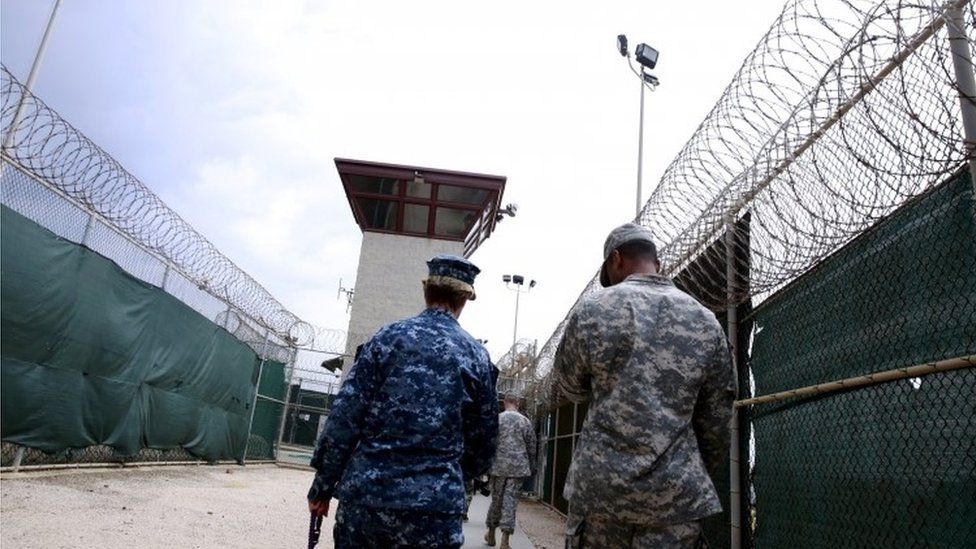Guantanamo Bay: US in largest detainee transfer under Obama
- Published

The US says it has sent 15 Guantanamo Bay detainees to the United Arab Emirates - the largest single transfer during President Barack Obama's administration.
The Pentagon says the transfer of 12 Yemeni nationals and three Afghans brings the total number of prisoners down to 61 at the US facility in Cuba.
The released inmates had been held without charge, some for over 14 years.
President Obama wants to close the prison before he leaves office.
What is Guantanamo Bay?
A detention facility on an American naval base in south-eastern Cuba.
The jail was opened by former US President George W Bush in January 2002 to accommodate foreign terror suspects after the 11 September attacks in 2001 and the subsequent US-led invasion of Afghanistan.
Some 779 men have been brought there since it opened.
Why does Obama want to close it?
The president says its existence harms partnerships with countries whose help the US needs in fighting terrorism.
Barack Obama: Guantanamo 'undermines our standing in the world'
He says Guantanamo Bay is contrary to US values, undermining the nation's standing in the world - a standing based on support for the rule of law.
Most inmates there have not been charged and, in February, Mr Obama lamented that "not a single verdict has been reached" on those there that have.
He also believes the facility fuels the recruitment of jihadists.
It's also expensive to run - $445m (£345m) annually.
So why has it not been closed?
One key point is that Mr Obama needs congressional approval and both houses have a Republican majority.
Republicans want not only to keep Guantanamo Bay prison open, but also send fighters from the so-called Islamic State there, as Aleem Maqbool reports
Many Republicans back keeping the facility open.
Ed Royce, the Republican chairman of the House Foreign Affairs Committee, condemned the latest releases, saying: "Once again, hardened terrorists are being released to foreign countries where they will be a threat."
Republican presidential candidate Donald Trump has said that, if elected, he will fill it with "bad dudes" and "bring back a hell of a lot worse than waterboarding" - a controversial interrogation technique human rights activists regard as torture.
The other major issue is what to do with the remaining inmates. Mr Obama has attempted to have them brought to the US for trial.
However, only one Guantanamo inmate has been transferred to the US for trial. Tanzanian Ahmed Ghailani was jailed for life in 2011 before Congress barred the transfer of any others.
Politicians from both parties have said that Guantanamo prisoners do not belong on US soil or in civilian prisons, arguing they are too dangerous.
What are the inmate numbers?
Afghans, Saudis and Yemenis have made up more than 60% of the prisoners, although about 50 different nationalities have been represented.
The vast majority of the 779 inmates were released under the previous administration of George W Bush. Nine have died at the prison.
Mr Obama has approved regular releases, totalling 161, with detainees heading for resettlement around the world.
Who are the key prisoners left?
Only 61 prisoners remain, of whom 20 are approved for release. The key figures left (all of whom have been charged and are currently in pre-trial hearings) are:
- Khalid Sheikh Mohammed - regarded as a senior operative in al-Qaeda. Has been charged over the 9/11 attacks. Reportedly admitted personally decapitating kidnapped US journalist Daniel Pearl in 2002
- Ramzi Binalshibh - alleged to be another senior al-Qaeda figure linked to 9/11 - tried to become one of the plane hijackers but failed to get a US visa
- Mustafa Ahmad al-Hawsawi - suspected financial chief used by Khalid Sheikh Mohammed to arrange the funding for 9/11
- Walid Bin Attash - allegedly helped in the preparation of the 1998 East Africa Embassy bombings and the USS Cole bombing and acted as a bodyguard to al-Qaeda leader Osama Bin Laden
What has happened to those released?
Figures from the office of the director of national intelligence show that, of the inmates released under George W Bush, 21% were confirmed to have re-engaged in militant activity, while 14% were suspected of having done so.
Of the releases under President Obama, only 5% were confirmed to have re-engaged in militant activity and 8% were suspected of having done so.
Many of those released have simply returned to their homelands. Many returning Afghans harbour resentment both at why they were sent to Guantanamo Bay and their treatment there. Many still report harassment by security forces although they insist they pose no threat.
Among the countries taking inmates in releases under Mr Obama are the UAE, Georgia, Senegal, Saudi Arabia, Slovakia, Morocco, the UK, Mauritania, Oman, Bosnia, Montenegro, Algeria, Kazakhstan, Uruguay, Estonia and El Salvador.
Inevitably the results have been mixed, given cultural differences.
Uruguay took six Arab men in December 2014 but later said it would take no more, arguing the ex-inmates had struggled to adapt to the country.
One inmate, Abu Bakker Qassi, a Uighur from north-western China, found himself working as a pizza chef cooking halal Italian food in Albania.
- Published17 April 2016
- Published4 April 2016
- Published31 March 2016
- Published24 February 2016
- Published23 February 2016
- Published14 January 2016
- Published7 January 2016